Jalisco
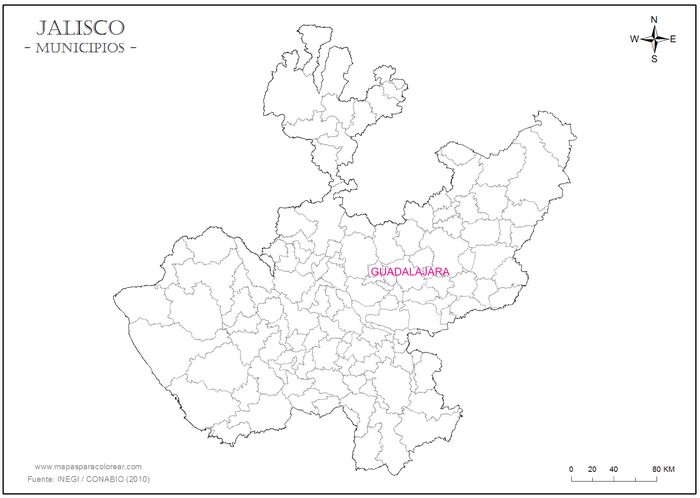
Jalisco is the sixth largest state in Mexico and located in the west central part of the country along the Pacific coast with Guadalajara as its capital. During the Mexican Revolution it had many battles fought on its soil and was one of the strongholds of Venustiano Carranza and Alvaro Obregón. Francisco “Pancho” Villa’s Ejército del Norte (Army of the North) also operated in Jalisco in 1914 and 1915 and coinage from the revolutionary period is attributed to this faction. Coins minted in Jalisco during the revolution were reportedlyGarza, 1932 minted in the old Federal mint in Guadalajara, active under the Republic from 1825 to 1895.
Jalisco coins were minted with a date of 1915 in at least five known denominations. The bulk of the coins minted include common issues of 1 centavo, 2 centavos and 5 centavos. Each of these issues all had a very similar design; however, the 10 centavos and 1 peso coins carry a different design altogether and are quite rare.
It appears the Jalisco 10 centavos was issued earlier, perhaps as a local issue, during the political vacuum between Obregón leaving for Mexico City and Villa occupying the state, although Garza states it was struck in early 1915 on orders of a Villista general. The balance of the coins were issued about the middle of 1915. These minor coins are the first issues of Villa’s Ejército del Norte. They are somewhat plain and do not inspire the passion among collectors that the Aguascalientes, Oaxaca or Chihuahua issues do.
The one centavo, two centavos are simple and similar in design. Designs consist of a Liberty cap and rays (with the obligatory LIBERTAD), the legend REPUBLICA MEXICAN above and the 1915 date below. The other side consists of the denomination superimposed on a cents sign, with EJERCITO DEL NORTE above and EDO. DE JAL. below.
Reported varieties include different (scarce) dies for the one-centavo denomination die, two centavos (both dies) and five centavos (also both dies). There are also reeded edges, plain edges, brass strikes, different diameter planchets within a denomination and various die rotations. Hughes believes that the different planchet sizes and die rotations are differences in preparation and strike and are of no major importance, although Gaytan(footnote)1969 reports die rotations as different varieties.
One centavo
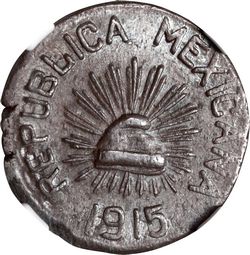
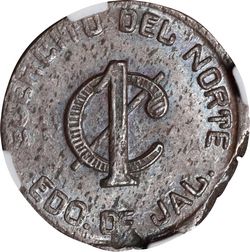
KM-675 Jalisco 1c (Stack’s-Bowers NYINC Auction, 19 January 2022, lot 7857)
Two centavos

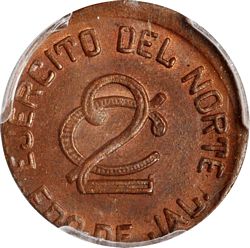
KM-676.1 Jalisco 2c Large cap variety (Stack’s-Bowers Auction,22 October 2022, lot 72394)
The three varieties of the 2c coin are detailed here.
Five centavos
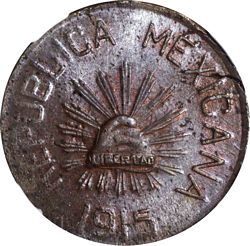
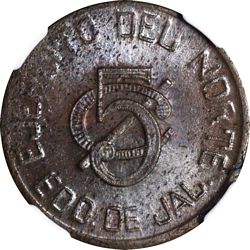
KM-677 Jalisco 5c (Stack’s-Bowers Auction,13 February 2019, lot 71549)
Ten centavos
The 10 centavos, struck earlier than the one, two and five centavos, is a different design. There is no suggestion on this coin that this is a Villa issue. The legend GOBIERNO LIBERAL DE JALISCO, MEX on the denomination side, and the state seal on the other side, suggests a state issue, perhaps similar to the state issue of Oaxaca.
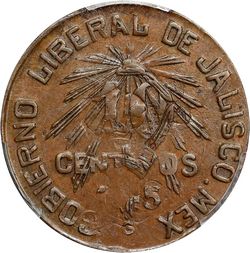
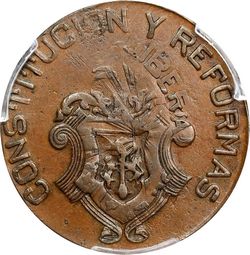
KM-678 Jalisco 10c with unique mint error (Stack’s Bowers auction, 1 November 2023, lot, 72205)
The above coin exhibits a fascinating error. The planchet appears to have received an off-centre strike which was then corrected with a flip-over double strike. The resulting piece displays on each side traces of the opposing side, offset due to the faulty initial strike.
One peso
The Jalisco one-peso is a crown-sized pattern in copper, almost identical to the Chihuahua 1915 Ejército del Norte one peso. Hughes prefers to believe the Jalisco peso was struck before the Chihuahua peso, as Villa was being north during 1915, eventually back into Jalisco. In addition , the name of his army evolved in Jalisco, eventually settling on Ejército del Norte. The Jalisco one-peso pattern is known only in copper and is possibly unique.
